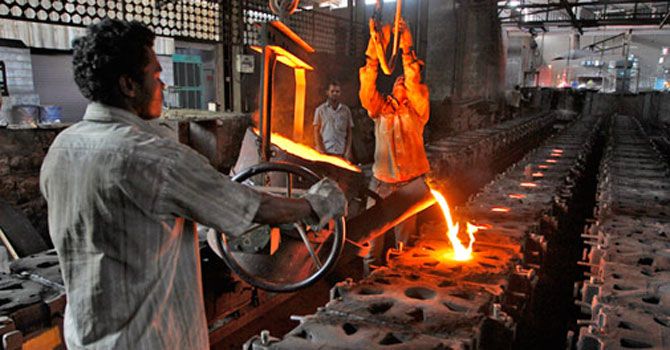
IIP falls 3.2% in Nov, sharpest in 4 years; capital goods contracts 24.4%; Retail inflation rises to 5.61% in December, food at 6.4%
Industrial output registered its sharpest fall in four years with the index of industrial production contracting 3.2 per cent in November, government data showed on Tuesday.
Earlier, Nikkei’s Manufacturing Purchasing Managers’ Index had fallen to a 28-month low in December.
Taken together, these key macroeconomic indicators suggest softening industrial growth in the second half of the current financial year.
Output is likely to suffer further in the coming months, as the full impact of the Chennai floods plays out.
What is especially worrying in the data is that capital goods, considered a proxy of investment demand, contracted sharply by 24.4 per cent, which suggests no sustained pick-up in investments.
The latest numbers come against the backdrop of growing clamour for the central government to deviate from its fiscal consolidation road map in order to boost public investments.
Separately, the consumer price index rose to 5.61 per cent in December, up from 5.41 per cent in November on the back of rising food prices. Pulses, the prime culprit, rose 46 per cent year-on-year.
With rabi sowing as of the first week of January remaining lower than last year, inflation is likely to continue in the same range, though with an upward bias.
This reduces the scope for further loosening of monetary policy.
The latest IIP numbers show that the manufacturing sector contracted by 4.4 per cent in November.
But, what is especially alarming is that 17 of the 22 sub-sectors contracted in November, up from five in the previous month.
According to CRISIL, declines were observed across consumer and investment sectors.
Among the consumer sectors, food products fell by 1.5 per cent, textiles by 1.9 per cent and wood and wood products by 14 per cent in November, while in the latter category, electrical machinery, machinery and equipment, basic metals and other non-metallic products saw the sharpest decline.
While the consumer durable goods segment grew by 12.5 per cent in November, it was in large part aided by a negative base effect, though there are some signs of demand, especially in urban areas picking up.
Going forward though the base effect is also likely to complicate matters further.
According to CARE, given the high base effect, “the manufacturing sector has to clock growth of 14 per cent on a month-on-month basis, i.e., over November to even maintain zero growth in December 2015.”
On the inflation front, food inflation edged up to 6.4 per cent in December, from six per cent in November.
Core inflation though stayed unchanged at 5.4 per cent for the fifth consecutive month.
According to analysts, inflation is likely to edge upwards with the low base effect withering out and with rabi sowing lower than last year’s levels.
Currently, sowing of wheat and oilseeds has declined 5.9 per cent and 3.8 per cent on-year, respectively, while sowing of pulses has dropped 0.3 per cent.
The image is used for representational purpose only. Photograph: Reuters









